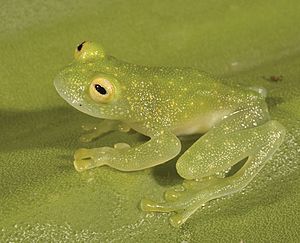Rio Azuela glass frog facts for kids
Quick facts for kids Rio Azuela glass frog |
|
|---|---|
 |
|
| Conservation status | |
| Scientific classification | |
| Synonyms | |
|
Centrolenella pellucida Lynch and Duellman, 1973 |
The Hyalinobatrachium pellucidum, also known as the Rio Azuela glass frog, is a type of frog. It belongs to the Centrolenidae family, which includes many "glass frogs." This frog lives in the lower mountain rainforests on the Andes mountains in Ecuador and Peru.
Its scientific name, pellucidum, comes from a Latin word meaning "transparent." This is because you can see through parts of its body, especially its belly skin. This makes its internal organs visible!
What It Looks Like
This tiny frog is about the size of your fingernail. Male frogs are around 20 to 22 millimeters long. Female frogs are a bit bigger, about 22 millimeters long. (A millimeter is a very small measurement, like the thickness of a credit card!)
The frog's snout, which is its nose area, looks like it's cut off. Its eardrum, called the tympanum, is partly hidden under its skin. The skin on its back is a little bumpy. Its back is light green with faint yellow spots.
The frog's fingers and toes are yellow and have some webbing between them. Its underside is clear, so you can see its heart through its belly skin. Its eyes have a pale silver-bronze color.
Male Rio Azuela glass frogs make a special sound to attract mates. This sound is a single, steady note. It does not change in how loud it is.
Where It Lives and How We Protect It
The Rio Azuela glass frog lives in lower mountain rainforests. It also lives in cloud forests. These are forests that are often covered in clouds. You can find them in both old, untouched forests and forests that have grown back after being cut down. They live at heights from about 500 to 1,740 meters above sea level. This means they live high up in the mountains.
These frogs are usually found at night. They sit on the top surfaces of leaves on trees and plants. They are often about 1.5 to 4 meters above small streams. Female frogs lay their eggs on plants. Sometimes, spiders might eat these eggs.
Sadly, this frog is in danger. Its habitat (the place where it lives) is shrinking. This is happening because of farming by small landowners. Logging, which is cutting down trees, also destroys their homes.
To help save these frogs, special programs have started. These programs try to breed the frogs in safe places away from their natural habitat. This helps make sure these amazing creatures don't disappear.
See also
 In Spanish: Rana de cristal fantasma para niños
In Spanish: Rana de cristal fantasma para niños


